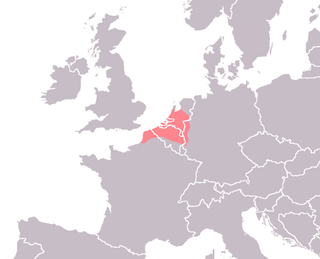
Back Oudnederlands Afrikaans اللغة الهولندية القديمة Arabic Neerlandés antiguu AST Старажытнанідэрландская мова Byelorussian Altniederländische Sprache German Neerlandés antiguo Spanish Muinaishollanti Finnish Vieux néerlandais French Aldnederlânsk Frisian Bahasa Belanda Kuno ID
| Old Dutch | |
|---|---|
| Old Low Franconian | |
| *thiudisc | |
| Native to | Holland, Austrasia, Zeeland and Flanders |
| Region | The Low Countries |
| Era | Gradually developed into Middle Dutch by mid-12th century[1][2] |
Early forms | |
| Runes, Latin (later) | |
| Language codes | |
| ISO 639-3 | odt |
odt | |
| Glottolog | oldd1237oldd1238 |
 The areas where the Old Dutch language was spoken | |
In linguistics, Old Dutch (Modern Dutch: Oudnederlands) or Old Low Franconian (Modern Dutch: Oudnederfrankisch) [3][4] is the set of dialects that evolved from Frankish spoken in the Low Countries during the Early Middle Ages, from around the 6th[5] or 9th[6] to the 12th century. Old Dutch is mostly recorded on fragmentary relics, and words have been reconstructed from Middle Dutch and Old Dutch loanwords in French.[7]
Old Dutch is regarded as the primary stage in the development of a separate Dutch language. It was spoken by the descendants of the Salian Franks who occupied what is now the southern Netherlands, northern Belgium, part of northern France, and parts of the Lower Rhine regions of Germany. It evolved into Middle Dutch around the 12th century. The inhabitants of northern Dutch provinces, including Groningen, Friesland, and the coast of North Holland, spoke Old Frisian, and some in the east (Achterhoek, Overijssel, and Drenthe) spoke Old Saxon.
- ^ Guy Janssens & Ann Marynissen: Het Nederlands vroeger en nu, 2nd ed., Acco, Leuven (België), 2005 (1st ed. 2003), p. 47-50.
- ^ Ann Marynissen: De lange weg naar een Nederlandse standaardtaal: Een beknopte geschiedenis van de standaardisering van het Nederlands, in: De vele gezichten van het Nederlands in Vlaanderen. Een inleiding tot de variatietaalkunde, edited by Gert De Sutter, Acco, Leuven / Den Haag, 2017, p. 60-79, here p. 61 (online)
- ^ van den Toorn, M. C.; Pijnenburg, W.J.J.; van Leuvensteijn, J.A.; van der Horst, J.M., eds. (1997). Geschiedenis van de Nederlandse taal (in Dutch). p. 37. (dbnl.org): "De term Oudnederlands (vanuit een ander perspectief ook wel Oudnederfrankisch genoemd) ..."
- ^ Janssens, G.; Marynissen, A. (2005). Het Nederlands vroeger en nu (in Dutch) (2nd ed.). pp. 38, 54.
- ^ van der Sijs, Nicoline (2019). 15 eeuwen Nederlandse taal (in Dutch). Gorredijk: Sterck & De Vreese. Page 55: "Uit de zesde eeuw dateren de oudst bekende geschreven woorden en tekstjes in de Lage Landen, waarmee de periode van het oud-Nederlands begint." [From the 6th century date the oldest known text from the Low Countries, with which the period of Old Dutch begins.]
- ^ De Vries, Jan W.; Willemyns, Roland; Burger, Peter (2003). Het verhaal van een taal (in Dutch). Amsterdam: Prometheus. pp. 12, 21–27. Page 27: "Aan het einde van de negende eeuw kan er zeker van Nederlands gesproken worden; hoe long daarvoor dat ook het geval was, kan niet met zekerheid worden uitgemaakt." [It can be said with certainty that Dutch was being spoken at the end of the 9th century; how long that might have been the case before that cannot be determined with certainty.]
- ^ Webster's New World Dictionary:[full citation needed] Old Dutch